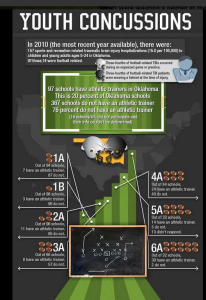
Sadly, I begin this entry with the story of a young man who lost his life 2 days ago following a “head injury” in a high school football game. I respectfully ask that you take a moment to think about the family, friends, and teammates of Ben Hamm from Wesleyan Christian School in Bartlesville, Oklahoma. This national story hits particularly close to home for me, as this school is only 30 miles from my doorstep.
With reports such as this come not only sadness, but also frustration and speculation.
Frustration because, regrettably, this is not the first young man to lose his life as the result of a head injury during the course of a football game in Oklahoma and probably won’t be the last. Following the report of Ben’s loss of life, I was contacted by a friend of mine who lost her nephew, Justin Barney, in an identical scenario 8 years ago. I met this friend during a presentation at the Oklahoma Capitol about medical care for Oklahoma high-school athletes, where she told her nephew’s story.
After hearing Justin’s story, I vowed that I would do everything within my power to prevent it from happening again. Through countless hours of lobbying legislators and school administrators; educating coaches, athletes, parents, and school nurses; and advocating for better safeguards for student-athletes; Justin’s aunt has continuously been there pushing with me. We certainly have made tremendous strides over the past 8 years, but clearly not enough has been done to prevent this from happening again. This issue demands everyone’s attention: coaches, parents, school administrators, and yes legislators. For every Ben and Justin, there are dozens of other kids who have lived and died under similar circumstances.
Speculation because, although I hate to speculate regarding the week, hours, and plays that led to Ben’s collapse, I can’t help but wonder if Ben had some prior concussive event leading up to his removal from the game. [We do know that according to recent reports that Ben suffered a concussion two years ago that kept it out of football the entire season.] It has been reported that coaches and parents reviewed the game film and saw nothing “out of the ordinary.” My follow-up question is “did they review the previous week, did they review the entire week of practice?”…because second impact syndrome could be a very real possibility in Ben’s case. It has also been reported that Wesleyan Christian High School (WCS) did everything that it could to prevent such an occurrence as required by law (coach concussion training, athlete education, etc.) and even adopting the tackling technique of the Seattle Seahawks. I would argue that it didn’t do “everything.” I have not seen any report that WCS employs a licensed athletic trainer or that an AT was present at that tragic game.
Athletic trainers are not required by law, and Oklahoma high school athletes have among the worst access to athletic training care. What if, in addition to the concussion law requirements, schools actually took the extra steps to provide the appropriate care that kids deserve? What if WCS employed an athletic trainer? What if Ben had complained of a simple “headache” at halftime, and an AT were present to complete a full assessment with comparisons to baseline measures…leading to removal from the game prior to that final incapacitating play? WHAT IF???
This speculation is not intended to blame WCS or any one coach, administrator, or legislator for this tragic loss of life, and I’m not saying that an AT would have prevented this with certainty. What I am saying is that an AT would’ve given Ben, Justin, and dozens of other kids a fighting chance to live a full and productive life. What is certain is that the time has come to expand upon the minimal protections afforded to players through concussion laws. The way I see it, in this day and age, if you can’t afford an Athletic Trainer….then you can’t afford football. #AT4All
ORIGINAL ARTICLE:
http://www.concussionconnection.com/oklahoma-hs-football-death-a-call-to-action/

